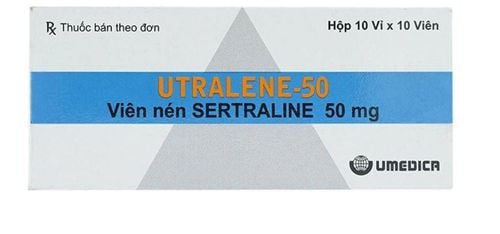This is an automatically translated article.
Conivaptan is a vasopressin antagonist, indicated for the treatment of hypovolemic or hypervolemic hyponatremia. What are the uses, doses and precautions when using Conivaptan?
1. What effects does Conivaptan have?
Conivaptan belongs to the class of vasopressin antagonists. Vasopressin is an antidiuretic hormone. High levels of this hormone can cause water and electrolyte imbalances, leading to water retention and decreased blood sodium levels.
Conivaptan is used to treat hyponatremia. Conivaptan improves urine flow without causing the body to lose too much sodium with urination.
2. Indications of the drug Conivaptan
Conivaptan is indicated to increase serum sodium levels in hospitalized patients with hypovolemic or hypervolemic hyponatremia. Use in patients with hypovolemic hyponatremia associated with heart failure only after consideration of other options.
Conivaptan is contraindicated in the following patients:
Hyponatremia with hypovolemia. Concomitant use of strong inhibitors of CYP3A. Anuria patient. In particular, solutions containing dextrose, including premixed conivaptan hydrochloride injection in 5% dextrose, are contraindicated in patients who are allergic to corn or corn products.
3. Dosage and usage of Conivaptan
Adults:
Treatment of hypovolemic or hypervolemic hyponatremia: The loading dose is 20 mg Conivaptan infused over 30 minutes, then 20 mg continuously over 24 hours, for 2-4 days. If serum sodium does not increase as desired, the dose may be increased to 40 mg/day. Discontinue Conivaptan if serum sodium levels rise too rapidly (>12 mEq/L over 24 hours). Observe the patient's vital signs, serum sodium, neurological status, and volume. Do not resume Conivaptan if serum sodium continues to rise. However, if hyponatremia persists or recurs and the patient has no evidence of neurological sequelae of rapid serum sodium elevation, Conivaptan can be continued and the dose reduced. The maximum dose is 40 mg Conivaptan per day. Doses of 80mg per day are not more effective than 40mg per day, but are associated with higher rates of infusion site reactions and other adverse events. The maximum duration of treatment with Conivaptan is 4 days. Children: The safety and efficacy of Conivaptan have not been established in children <18 years of age.
Patients with hepatic impairment: Mild to severe hepatic impairment (Child-Pugh class A, B or C) should receive a loading dose of 10 mg, followed by 10 mg daily by continuous IV infusion over 24 hours for 2-4 days ( up to 4 days). If serum sodium does not increase as desired, the dose of Conivaptan can be adjusted to 20 mg daily.
Patients with renal impairment
If Clcr > 60 mL/min: No dosage adjustment of Conivaptan is required. If Clcr 30-60 mL/min: Conivaptan loading dose is 10 mg, followed by 10 mg daily for 2-4 days (maximum 4 days). If serum sodium does not increase as desired, the dose of Conivaptan can be adjusted to 20 mg daily. If Clcr < 30 mL/min: Conivaptan is not recommended. Elderly: The manufacturer does not make specific recommendations.
4. What are the side effects of Conivaptan?
Patients using Conivaptan may experience side effects including:
Common: Infusion site reactions such as erythema, pain, phlebitis, headache, thirst, peripheral edema, vomiting, diarrhea, constipation, hypokalemia, hypertension, orthostatic hypotension, hyponatremia, anemia, confusion. Uncommon: Hypoglycemia, oral candidiasis, urinary tract infection, dehydration, hematuria, polyuria, pneumonia, sore throat. Rare: Cardiac arrhythmia, sepsis. Patients should seek medical attention immediately if they have the following signs: confusion, irregular heartbeat, extreme thirst, increased urination, leg discomfort, muscle weakness, difficulty speaking, difficulty swallowing, weakness , mood swings, muscle spasms or weakness in the arms and legs, seizures.
5. Notes when using the drug Conivaptan
Safety in patients with hypervolemic hyponatremia associated with heart failure is limited. Adverse events in heart failure, atrial arrhythmias and sepsis have been reported. Use only in patients with hypervolemic hyponatremia associated with heart failure after consideration of other options. Conivaptan is not indicated for the treatment of congestive heart failure. Elevated serum sodium > 12 mEq/L over 24 hours may cause gastrointestinal disturbances, dysphagia, coma, altered sensation, quadriplegia, convulsions, coma, or death. A slower rate of sodium correction is recommended in susceptible patients including those with severe malnutrition, alcoholism, or advanced liver disease. Infusion site reactions may occur and may require discontinuation in some cases. This reaction can occur even when Conivaptan is infused at the recommended infusion rate. Conivaptan should only be injected into a large vein, changing the infusion site every 24 hours. For patients who experience volume depletion or hypotension while taking Conivaptan, the drug should be discontinued and volume status and vital signs regularly monitored. After the patient is no longer hypotensive and blood volume normal, Conivaptan can be continued at the reduced dose if the patient remains hyponatremic. Patients should follow their doctor's instructions about the type and amount of fluids they should drink. In some cases, drinking too much liquid may not be safe. Avoid getting up too quickly from a sitting or lying position, as the patient may feel dizzy and fall. Pregnancy: The risk of major birth defects and miscarriage with Conivaptan is unknown. Therefore, Conivaptan should only be used when absolutely necessary. Lactation: Breast-feeding should be discontinued or Conivaptan should be discontinued.
6. Conivaptan drug interactions
The following are interactions to be aware of when using Conivaptan:
CYP3A inhibitors including antifungals, azoles, clarithromycin, ritonavir may increase plasma concentrations of Conivaptan. Therefore, concomitant use of these drugs with Conivaptan is contraindicated. Conivaptan may increase the concentration of drugs metabolised by CYP3A including amlodipine, HMG-CoA inhibitors, midazolam. Therefore, avoid concomitant use of Conivaptan with drugs metabolised primarily by CYP3A. It is advisable to wait approximately 1 week after discontinuing Conivaptan and initiating treatment with a CYP3A metabolite. Concurrent use of Conivaptan with Digoxin will increase the concentration of Digoxin. Digoxin levels should be monitored when co-administered with Conivaptan. The article has provided an overview of the drug Conivaptan. The information above is for reference only and cannot replace the advice of a physician. Patients should consult their doctor or pharmacist for advice before using Conivaptan.













